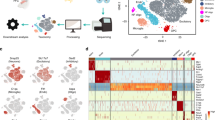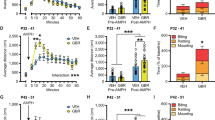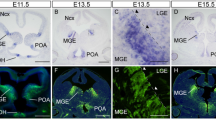Abstract
Alterations of the dopaminergic system are associated with the cognitive and functional dysfunctions that characterize complex neuropsychiatric disorders. We modeled a dysfunctional dopaminergic system using mice with targeted ablation of dopamine (DA) D2 autoreceptors in mesencephalic dopaminergic neurons. Loss of D2 autoreceptors abolishes D2-mediated control of DA synthesis and release. Here, we show that this mutation leads to a profound alteration of the genomic landscape of neurons receiving dopaminergic afferents at distal sites, specifically in the prefrontal cortex. Indeed, we observed a remarkable downregulation of gene expression in this area of ~2000 genes, which involves a widespread increase in the histone repressive mark H3K9me2/3. This reprogramming process is coupled to psychotic-like behaviors in the mutant mice. Importantly, chronic treatment with a DA agonist can revert the genomic phenotype. Thus, cortical neurons undergo a profound epigenetic reprogramming in response to dysfunctional D2 autoreceptor signaling leading to altered DA levels, a process that may underlie a number of neuropsychiatric disorders.
This is a preview of subscription content, access via your institution
Access options
Subscribe to this journal
Receive 12 print issues and online access
$259.00 per year
only $21.58 per issue
Buy this article
- Purchase on Springer Link
- Instant access to full article PDF
Prices may be subject to local taxes which are calculated during checkout





Similar content being viewed by others
References
Jaenisch R, Bird A . Epigenetic regulation of gene expression: how the genome integrates intrinsic and environmental signals. Nat Genet 2003; 33 (Suppl): 245–254.
Borrelli E, Nestler EJ, Allis CD, Sassone-Corsi P . Decoding the epigenetic language of neuronal plasticity. Neuron 2008; 60: 961–974.
Howes OD, Kapur S . The dopamine hypothesis of schizophrenia: version III—the final common pathway. Schizophr Bull 2009; 35: 549–562.
Kuepper R, Skinbjerg M, Abi-Dargham A . The dopamine dysfunction in schizophrenia revisited: new insights into topography and course. Handb Exp Pharmacol 2012; 212: 1–26.
Lyon GJ, Abi-Dargham A, Moore H, Lieberman JA, Javitch JA, Sulzer D . Presynaptic regulation of dopamine transmission in schizophrenia. Schizophr Bull 2011; 37: 108–117.
Miyake N, Thompson J, Skinbjerg M, Abi-Dargham A . Presynaptic dopamine in schizophrenia. CNS Neurosci Ther 2011; 17: 104–109.
Heinz A, Romero B, Gallinat J, Juckel G, Weinberger DR . Molecular brain imaging and the neurobiology and genetics of schizophrenia. Pharmacopsychiatry 2003; 36 (Suppl 3): S152–S157.
Howes O, Bose S, Turkheimer F, Valli I, Egerton A, Stahl D, et al. Progressive increase in striatal dopamine synthesis capacity as patients develop psychosis: a PET study. Mol Psychiatry 2011; 16: 885–886.
Howes OD, Egerton A, Allan V, McGuire P, Stokes P, Kapur S . Mechanisms underlying psychosis and antipsychotic treatment response in schizophrenia: insights from PET and SPECT imaging. Curr Pharm Des 2009; 15: 2550–2559.
Bertolino A, Knable MB, Saunders RC, Callicott JH, Kolachana B, Mattay VS, et al. The relationship between dorsolateral prefrontal N-acetylaspartate measures and striatal dopamine activity in schizophrenia. Biol Psychiatry 1999; 45: 660–667.
Meyer-Lindenberg A, Miletich RS, Kohn PD, Esposito G, Carson RE, Quarantelli M, et al. Reduced prefrontal activity predicts exaggerated striatal dopaminergic function in schizophrenia. Nat Neurosci 2002; 5: 267–271.
Rice ME, Patel JC, Cragg SJ . Dopamine release in the basal ganglia. Neuroscience 2011; 198: 112–137.
Rouge-Pont F, Usiello A, Benoit-Marand M, Gonon F, Piazza PV, Borrelli E . Changes in extracellular dopamine induced by morphine and cocaine: crucial control by D2 receptors. J Neurosci 2002; 22: 3293–3301.
Benoit-Marand M, Borrelli E, Gonon F . Inhibition of dopamine release via presynaptic D2 receptors: time course and functional characteristics in vivo. J Neurosci 2001; 21: 9134–9141.
Anzalone A, Lizardi-Ortiz JE, Ramos M, De Mei C, Hopf FW, Iaccarino C, et al. Dual control of dopamine synthesis and release by presynaptic and postsynaptic dopamine D2 receptors. J Neurosci 2012; 32: 9023–9034.
Jasencakova Z, Scharf AN, Ask K, Corpet A, Imhof A, Almouzni G, et al. Replication stress interferes with histone recycling and predeposition marking of new histones. Mol Cell 2010; 37: 736–743.
Kumar A, Choi KH, Renthal W, Tsankova NM, Theobald DE, Truong HT, et al. Chromatin remodeling is a key mechanism underlying cocaine-induced plasticity in striatum. Neuron 2005; 48: 303–314.
Paylor R, Crawley JN . Inbred strain differences in prepulse inhibition of the mouse startle response. Psychopharmacology 1997; 132: 169–180.
Errico F, Rossi S, Napolitano F, Catuogno V, Topo E, Fisone G, et al. D-aspartate prevents corticostriatal long-term depression and attenuates schizophrenia-like symptoms induced by amphetamine and MK-801. J Neurosci 2008; 28: 10404–10414.
Wood MA, Kaplan MP, Brensinger CM, Guo W, Abel T . Ubiquitin C-terminal hydrolase L3 (Uchl3) is involved in working memory. Hippocampus 2005; 15: 610–621.
Maze I, Noh KM, Allis CD . Histone regulation in the CNS: basic principles of epigenetic plasticity. Neuropsychopharmacology 2013; 38: 3–22.
Akbarian S, Huang HS . Epigenetic regulation in human brain—focus on histone lysine methylation. Biol Psychiatry 2009; 65: 198–203.
Russo SJ, Nestler EJ . The brain reward circuitry in mood disorders. Nat Rev Neurosci 2013; 14: 609–625.
Barski A, Cuddapah S, Cui K, Roh TY, Schones DE, Wang Z, et al. High-resolution profiling of histone methylations in the human genome. Cell 2007; 129: 823–837.
Fodor BD, Kubicek S, Yonezawa M, O'Sullivan RJ, Sengupta R, Perez-Burgos L, et al. Jmjd2b antagonizes H3K9 trimethylation at pericentric heterochromatin in mammalian cells. Genes Dev 2006; 20: 1557–1562.
Rojas P, Joodmardi E, Hong Y, Perlmann T, Ogren SO . Adult mice with reduced Nurr1 expression: an animal model for schizophrenia. Mol Psychiatry 2007; 12: 756–766.
Emamian ES, Hall D, Birnbaum MJ, Karayiorgou M, Gogos JA . Convergent evidence for impaired AKT1-GSK3beta signaling in schizophrenia. Nat Genet 2004; 36: 131–137.
Arguello PA, Gogos JA . Modeling madness in mice: one piece at a time. Neuron 2006; 52: 179–196.
Jones CA, Watson DJ, Fone KC . Animal models of schizophrenia. Br J Pharmacol 2011; 164: 1162–1194.
Seeman P . All roads to schizophrenia lead to dopamine supersensitivity and elevated dopamine D2(high) receptors. CNS Neurosci Ther 2011; 17: 118–132.
Yoon T, Okada J, Jung MW, Kim JJ . Prefrontal cortex and hippocampus subserve different components of working memory in rats. Learn Mem 2008; 15: 97–105.
Papaleo F, Yang F, Garcia S, Chen J, Lu B, Crawley JN, et al. Dysbindin-1 modulates prefrontal cortical activity and schizophrenia-like behaviors via dopamine/D2 pathways. Mol Psychiatry 2012; 17: 85–98.
Goto Y, Grace AA . The dopamine system and the pathophysiology of schizophrenia: a basic science perspective. Int Rev Neurobiol 2007; 78: 41–68.
Whetstine JR, Nottke A, Lan F, Huarte M, Smolikov S, Chen Z, et al. Reversal of histone lysine trimethylation by the JMJD2 family of histone demethylases. Cell 2006; 125: 467–481.
Acknowledgements
We thank Drs F Torri and C De Mei for assistance and interest in the initial phase of this study; Dr P Sassone-Corsi for critical discussions and reading of the manuscript. This work was supported by NIH Grant DA024689 and INSERM-44790 (to EB).
Author information
Authors and Affiliations
Corresponding author
Ethics declarations
Competing interests
The authors declare no conflict of interest.
Additional information
Supplementary Information accompanies the paper on the Molecular Psychiatry website
Rights and permissions
About this article
Cite this article
Brami-Cherrier, K., Anzalone, A., Ramos, M. et al. Epigenetic reprogramming of cortical neurons through alteration of dopaminergic circuits. Mol Psychiatry 19, 1193–1200 (2014). https://doi.org/10.1038/mp.2014.67
Received:
Revised:
Accepted:
Published:
Issue Date:
DOI: https://doi.org/10.1038/mp.2014.67
This article is cited by
-
Reinstatement of nicotine conditioned place preference in a transgenerational model of drug abuse vulnerability in psychosis: Impact of BDNF on the saliency of drug associations
Psychopharmacology (2023)
-
Repetitive transcranial magnetic stimulation induces long-lasting changes in protein expression and histone acetylation
Scientific Reports (2015)



